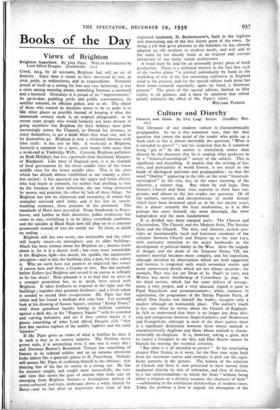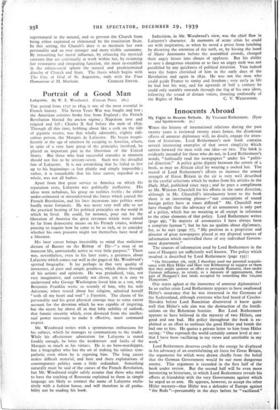Culture and Diarchy
THE literature of our modern culture is characteristically propagandist. So far is this statement true, that the first question that enters the mind of the reader who picks up a book such as this is almost inevitably the question, " What is it intended to prove? " ; and his suspicion that he is somehow being " got at " by the author is stimulated, rather than allayed, by the discovery that he is reading what professes to be a " historical-sociological " survey of the subject. This is significant and disturbing. It implies that the writing of his- tory, and particularly of world history, is too much in the hands of ideological partisans and propagandists: so that the word " Outline " appearing in the title, or the term " historical- sociological " in the text, has, in the exact meaning of the adjective, a sinister ring. But, taken by and large, Don Sturzo's Church and State rises superior to these base sus- picions, and almost to the last evades our question. Of all the outlines, surveys, and interpretations of world history which have been bestowed upon us in the last twenty years, this is almost certainly the least tendentious, as it is also perhaps the most learned, the most thorough, the most independent and the most fundamental.
It is divided into three unequal parts: The Church and Christendom, The Church and the Modern State, The Secular State and the Church. The first, and shortest, section pro- vides an incomparably lucid and luminous summary of the relations between Church and Empire up to the year 1313, with particular attention to the major landmarks in the development of political theory in the West. After the tragedy of Anagni and the death of the Emperor Henry VII, the author's material becomes more complex, and his exposition, although enriched by observations which are both suggestive and incisive, is congested with much secondary matter and many unnecessary details which are not always accurate: for example, Pace was not yet Dean of St. Paul's in 1517, and Wolsey was never Archbishop of Canterbury (p. 204). In the third section, which has the same defects of arrange- ment, a very proper, and a very unusual, regard is paid to Papal Encyclicals and pronouncements ; while, contrary to expectation, the programme of the Italian Popular Party, of which Don Sturzo was himself the leader, occupies only a modest although an honourable place. The author's touch is less sure when he writes about the Church of England: he fails to understand that there is no longer any deep divi- sion and antagonism between Anglo-Catholics and Modernists and Evangelicals, although in each of the three parties there is a significant distinotion between those whose outlook is characteristically Anglican and those whose outlook is charac- teristically um-Anglican. It is, however, asking a great deal to expect a foreigner to see this, and Don Sturzo cannot be blamed for missing the essential criterion.
" But what is it all intended to prove? " In his concluding chapter Don Sturzo, as it were, for the first time steps back from his enormous canvas and attempts to pick out the signi- ficant patterns in the picture. The history of the relations of Church and State ds now perceived to have moved from mediaeval diarchy by way of toleration, and then of laicism, to a laic confessionalism—in which the State " without being either a religion or a divinity assumes the character of both " —culminating in the totalitarian dictatorships of modern times. Today the problem is how to impede the absorption of the
supernatural in the natural, and to prevent the Church from being either exploited or eliminated by the totalitarian State. In this setting, the Church's duty is to maintain her own personality and an ever stronger and more visible autonomy. By reasserting her moral influence, by releasing the mystical currents that are continually at work within her, by resuming her restorative and integrating function, she must re-establish in the ethico-social sphere the natural and predetermined diarchy of Church and State. The thesis which begins with The City of God of St. Augustine, ends with the True































 Previous page
Previous page